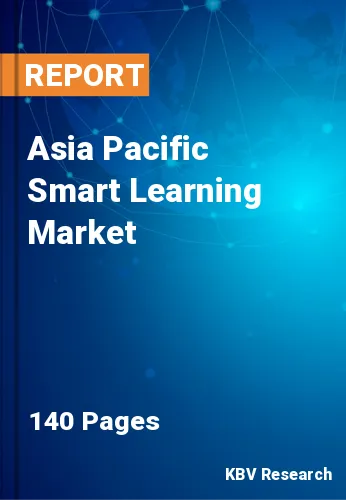The Asia Pacific Smart Learning Market would witness market growth of 21.4% CAGR during the forecast period (2022-2028).
Various technologies were launched in the education sector during the previous century, but not all of them were adopted. They were frequently teacher-centric technologies designed to supplement traditional teaching approaches that were not compelling to newer generations of students who were rapidly advancing along with the digital adoption curve. The establishment of a smart education environment nowadays necessitates a more strategic use of digital technologies. Teachers can deploy innovations focusing on the student-student as well as teacher-student collaboration to make better use of classroom tools.
Smart education and learning solutions promote the utilization of mobile instruments and place a priority on the learner's mobility. It also offers a customizable learning approach that can be used to replace conventional classroom teaching approaches. A growing number of educational institutions are embracing the smart education concept by implementing high-tech teaching methods like whiteboards, smart notebooks, and other technologies.
The rising trend of digitalization in several sectors of the country is expediting the utilization of numerous smart learning tools. The increasing number of government initiatives in several countries is also playing a major role in the adoption of digital technologies and tools all over the region. For example, the Digital India program is an initiative taken by the government of India in order to bring digitalization across all the processes in the country. The vision of the Digital India program is to transform this country into a knowledge-based economy and a digitally empowered society. It would ensure that citizens have access to all the necessary government services via the internet. It would also increase public accountability by encouraging government services to be delivered electronically. The services include banking, finance, schooling, and various others
The China market dominated the Asia Pacific Smart Learning Market by Country in 2021, and would continue to be a dominant market till 2028; thereby, achieving a market value of $10,734.6 million by 2028. The Japan market is anticipated to grow at a CAGR of 20.6% during (2022 - 2028). Additionally, The India market would display a CAGR of 22.1% during (2022 - 2028).
Based on Component, the market is segmented into Hardware, Software (Standalone and Integrated), and Services. Based on Hardware Type, the market is segmented into Interactive displays, Interactive whiteboards, Smartboards, and Others. Based on Standalone Type, the market is segmented into LMS/LCMS, Student Information System, Classroom Management Software, Language Learning Software, and Others. Based on Learning Type, the market is segmented into Asynchronous Learning and Synchronous Learning. Based on End User, the market is segmented into Academic, Enterprises, and Government. Based on countries, the market is segmented into China, Japan, India, South Korea, Singapore, Malaysia, and Rest of Asia Pacific.
Free Valuable Insights: The Worldwide Smart Learning Market is Projected to reach USD 128.4 Billion by 2028, at a CAGR of 20.3%
The market research report covers the analysis of key stake holders of the market. Key companies profiled in the report include Pearson PLC, IBM Corporation, Oracle Corporation, SAP SE, Google LLC, Microsoft Corporation, Cisco Systems, Inc., Adobe, Inc., Qisda Corporation (BenQ), and Samsung Electronics Co., Ltd. (Samsung Group)
By Component
By Learning Type
By End User
By Country
Our team of dedicated experts can provide you with attractive expansion opportunities for your business.

